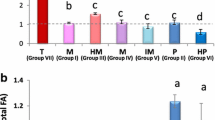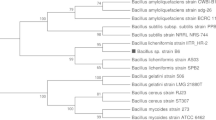Abstract.
Carvacrol, a natural antimicrobial compound present in the essential oil fraction of oregano and thyme, is bactericidal towards Bacillus cereus. A decrease of the sensitivity of B. cereus towards carvacrol was observed after growth in the presence of non-lethal carvacrol concentrations. A decrease of the melting temperature (T m) of membranes from 20.5 °C to 12.6 °C was the immediate effect of the addition of carvacrol. Cells adapted to 0.4 mM carvacrol showed a lower membrane fluidity than non-adapted cells. Adaptation of 0.4 mM carvacrol increased the T m from 20.5 °C to 28.3 °C. The addition of carvacrol to cell suspensions of adapted B. cereus cells decreased T m again to 19.5 °C, approximately the same value as for the non-adapted cells in the absence of carvacrol. During adaptation, changes in the fatty acid composition were observed. The relative amount of iso-C13:0, C14:0 and iso-C15:0 increased and cis-C16:1 and C18:0 decreased. The head-group composition also changed, two additional phospholipids were formed and one phospholipid was lacking in the adapted cells. It could be concluded that B. cereus adapts to carvacrol when present at non-lethal concentrations in the growth medium by lowering its membrane fluidity by changing the fatty acid and head-group composition.
Similar content being viewed by others
Author information
Authors and Affiliations
Additional information
Electronic Publication
Rights and permissions
About this article
Cite this article
Ultee, A., Kets, E., Alberda, M. et al. Adaptation of the food-borne pathogen Bacillus cereus to carvacrol. Arch Microbiol 174, 233–238 (2000). https://doi.org/10.1007/s002030000199
Received:
Revised:
Accepted:
Issue Date:
DOI: https://doi.org/10.1007/s002030000199




